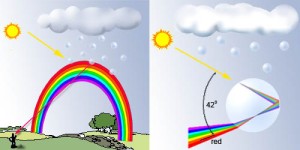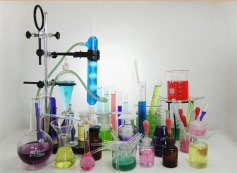Despite several important publications (James Hannam, David C. Lindberg, and Edward Grant), the awareness of the foundations of the modern science in Middle Ages is still low among the majority of scientists. While the popular opinion sees the Renaissance thinkers (including Zabarella, Copernicus, Gilbert, Kepler and Galilei) as progenitors of a new method, it was the tension between thinkers at the medieval universities in Oxford and Paris that brought the origin of science as we know it today. Moreover, this tension between the two schools goes back to the differences between the proponents of Plato and Aristotle, which helps us to recognize and locate the actual  origin of scientific endeavor in antiquity.
origin of scientific endeavor in antiquity.
In his philosophy of nature Plato combined Pythagorean attempt to understand the cosmos and its phenomena in terms of mathematics and number with Democritus’ purely mechanical view of causation defined in terms of movements and collisions of atoms (for Plato triangle is an atomic element). Therefore, he saw mathematics as a way of arriving at the ultimate and basic reality itself, which in sensual experience is given only in ephemeral appearances. Mathematics became for him a path leading to the contemplation of eternal Ideas, which find their temporal and imperfect exemplifications in the reality accessible for us.
This emphasis on mathematical component in scientific explanation was followed by medieval thinkers in Oxford. Even if the most prominent scientists among them, such as Robert Grosseteste (ca. 1168-1253) and his disciple Roger Bacon (ca. 1214-1294), said about the indispensability of experience and experiments (“in thought if not in deed”), which are supposed to verify or falsify the outcomes of physics, it is doubtful that they performed real experiments. Neither did they develop any actual method or theory of verification and falsification. They found mathematics being essential not only for understanding of all sciences, but even of the entire world in its essence. Their endeavor was supported by the nominalism of William of Ockham (ca. 1287-1347) who questioned the realism of Aristotelian common natures, claiming that terms such as quantity, motion, time, space, velocity and causality, had no other real referents than an individual substance. Although such a strong trust in theoretical and mathematical method is questionable from the contemporary point of view, we cannot forget that it was precisely this attitude that brought an important development of the philosophy of motion, which can be regarded as an origin of kinetics.
 On the other pole of the methodological reflection among medieval scientists we find those who did not trust mathematics as much as the empirical temper of Aristotelian tradition (rediscovered at that time at the University of Paris). They believed in man’s ability both to come to know the world of nature and to discover and name the causes of its phenomena. They regarded mathematics, as a formal and abstract discipline which applied to reality enables us to construe a subalternated type of scientific knowing, which is abstracted from empirical and sensual experience. That is why they valued more sensual experience and experiment, as well as deduction and hypothesis. Consequently, it was the academia in Paris that gave start to the reflection on dynamical problems, thus supporting the origin of a systematic science of mechanics (which – as we have seen – had its kinematic component established at Oxford).
On the other pole of the methodological reflection among medieval scientists we find those who did not trust mathematics as much as the empirical temper of Aristotelian tradition (rediscovered at that time at the University of Paris). They believed in man’s ability both to come to know the world of nature and to discover and name the causes of its phenomena. They regarded mathematics, as a formal and abstract discipline which applied to reality enables us to construe a subalternated type of scientific knowing, which is abstracted from empirical and sensual experience. That is why they valued more sensual experience and experiment, as well as deduction and hypothesis. Consequently, it was the academia in Paris that gave start to the reflection on dynamical problems, thus supporting the origin of a systematic science of mechanics (which – as we have seen – had its kinematic component established at Oxford).
 The experimental method and practice of the medieval science in Paris had its origins in the work of Peter Peregrinus of Maricourt (fl. 1269). His contemporary Roger Bacon was most impressed by his achievements and praised him saying that “he is a master of experiment. Through experiment he gains knowledge of natural things, medical, chemical, indeed of everything in the heavens or earth” (Opus tertium, cap. 13). Peter’s greatest contribution was naming magnet’s poles after the celestial poles, which was preceded by a series of experiments with loadstone and iron needle, carefully described in the first part of his De magnete. He also developed and employed a methodology of falsification with considerable skill in order to refute the opinion of those claiming that the loadstone derives its power from the place where it was mined. His experiments allow him to prove that the magnet gets its power from the poles of the heavens.
The experimental method and practice of the medieval science in Paris had its origins in the work of Peter Peregrinus of Maricourt (fl. 1269). His contemporary Roger Bacon was most impressed by his achievements and praised him saying that “he is a master of experiment. Through experiment he gains knowledge of natural things, medical, chemical, indeed of everything in the heavens or earth” (Opus tertium, cap. 13). Peter’s greatest contribution was naming magnet’s poles after the celestial poles, which was preceded by a series of experiments with loadstone and iron needle, carefully described in the first part of his De magnete. He also developed and employed a methodology of falsification with considerable skill in order to refute the opinion of those claiming that the loadstone derives its power from the place where it was mined. His experiments allow him to prove that the magnet gets its power from the poles of the heavens.
But the most outstanding piece of experimental work in the High Middle Ages was completed by a Dominican friar Theodoric of Freiburg (ca. 1250-1310), who studied at the University of Paris shortly after Aquinas’ death and belonged to the same German province of Teutonia as Albert the Great, being one of his successors in the provincial office. Besides a large number of opuscula in philosophy and theology – obliged by the master of the Order, Aymeric de Plaisance – he wrote his treatise “On the Rainbow and Radiant Impressions” (De iride et radialibus impressionibus), which describes his scientific experimental work. William Wallace praises the ingenuity of his work saying that:
 “Theodoric’s place in the history of optics is guaranteed by his detailed analysis of the primary and secondary rainbows, of lunar and solar halos, and of other optical phenomena appearing in the earth’s atmosphere. At a time when Peter Peregrinus provided the only real precedent for experimentation, Theodoric set about systematically investigating the paths of light rays that generate radiant colors in the earth’s atmosphere, and did so largely by experimental means. He utilized spherical flasks filled with water, crystalline spheres, and prisms of various shapes to trace the refractions and reflections involved in the production of radiant colors. He also worked out a theory of elements that was related to his search for optical principles, and which stimulated experimentation along lines that could more properly be called verification than anything we have seen thus far. (…) He thus has been hailed as a precursor of modern science and his work read as though he were using mathematical and experimental techniques developed only in the seventeenth century” (Causation and Scientific Explanation, Vol. 1).
“Theodoric’s place in the history of optics is guaranteed by his detailed analysis of the primary and secondary rainbows, of lunar and solar halos, and of other optical phenomena appearing in the earth’s atmosphere. At a time when Peter Peregrinus provided the only real precedent for experimentation, Theodoric set about systematically investigating the paths of light rays that generate radiant colors in the earth’s atmosphere, and did so largely by experimental means. He utilized spherical flasks filled with water, crystalline spheres, and prisms of various shapes to trace the refractions and reflections involved in the production of radiant colors. He also worked out a theory of elements that was related to his search for optical principles, and which stimulated experimentation along lines that could more properly be called verification than anything we have seen thus far. (…) He thus has been hailed as a precursor of modern science and his work read as though he were using mathematical and experimental techniques developed only in the seventeenth century” (Causation and Scientific Explanation, Vol. 1).
The core of the originality and novelty of his method consists in the fact, that Theodoric did not only observe the way in which rainbows are produced in nature (experience), but also attempted to duplicate the process under controlled laboratory conditions, where he could observe all component factors in detail (experiment). While those searching for the material cause of a rainbow saw it in a raincloud (they treated a spherical flask filled with water as a miniature of a cloud), Theodoric saw a globe of water in laboratory setting as a magnified raindrop. This observation helped him to understand that the entire rainbow is an aggregate of partial spectra produced by individual drops.
 Wallace notices that Theodoric mentions the term experiment (experimentum) at least 12 times in De iride. He develops a deliberate empirical procedure, at times involving measurement, in order to verify or falsify a proposed explanation. It is hard not to see in his methodology a direct link to the hypothetical-deductive method of modern and contemporary science. What is most important from my perspective (following Wallace), is the fact that Theodoric does all this in the context of an underlying Aristotelian methodology, concentrated on the search for four causes of the rainbow (even if he concentrates on material and efficient causes, more than on formal and final). This attitude is based on an underlying metaphysical realism, which searches for causes in the real, physical world, rather than in the mathematical sphere, which naturally cannot be neglected.
Wallace notices that Theodoric mentions the term experiment (experimentum) at least 12 times in De iride. He develops a deliberate empirical procedure, at times involving measurement, in order to verify or falsify a proposed explanation. It is hard not to see in his methodology a direct link to the hypothetical-deductive method of modern and contemporary science. What is most important from my perspective (following Wallace), is the fact that Theodoric does all this in the context of an underlying Aristotelian methodology, concentrated on the search for four causes of the rainbow (even if he concentrates on material and efficient causes, more than on formal and final). This attitude is based on an underlying metaphysical realism, which searches for causes in the real, physical world, rather than in the mathematical sphere, which naturally cannot be neglected.
The whole story shows an important interplay between the two radically different approaches to reality and scientific method in Oxford and Paris. Not without tensions, this dispute gave birth to modern science, and it gives me a great joy that I find a Dominican friar among its precursors.
References:
William Wallace, Causality and Scientific Explanation, Vol. 1
James Hannam, God’s Philosophers: How the Medieval World Laid the Foundations of Modern Science
